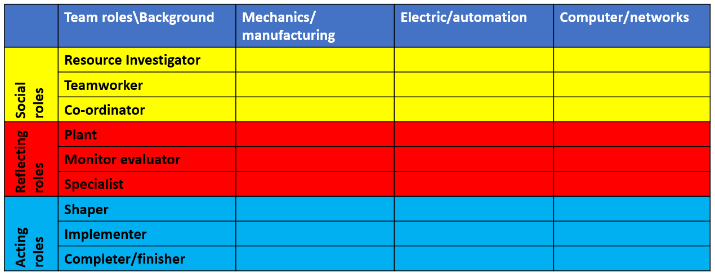Student Teams
Formation of successful student teams.
In the last element we studied the importance of learning spaces for efficient, effective and engaging learning processes for Industry 4.0.
In this element we will study specific factors which are important for forming student-teams that are successful in learning Industry 4.0 aspects by solving learning tasks.
In TEFFIC we have identified two major axis that are important when forming the teams:
- To provide a platform for acquiring multidisciplinary competence, the teams should be composed by students with different background or preferences in engineering fields. Examples of this is mechanics, manufacturing, industrial economics, electrics, mechanics, computer sciences and so on.
- The second axis is the different roles that must be filled in a group which are related to differences in the student's personality or preferences.

The
figure shows a matrix that illustrate the different roles and profiles that
should be present in a team. It looks quite complex, but we will try to
simplify further on.
The different student background or field of interest are quite self-explanatory, but the role or personality axis, demands a further explanation.
One approach to forming successful student teams is based on the research of Dr. Meredith Belbin. This is also the foundation for proven tools that are applicable when forming well-functioning teams.
Belbin describes nine different roles, divided into three main categories that normally are present in a successful team. The good news is that a person can cover several roles in a category, but it is important that the three categories are catered for.
The first category is the thought-oriented roles:
The analytic, or monitor evaluator, is soberly, strategic and sharp minded. Sees all options and is precise in judgements.
The specialist is oriented towards the subject at hand, self-motivated and focused on her work. Represents professional pride and professionalism within her field.
The plant, or ideator, is creative, imaginative, unconventional. Solves difficult problems.
The second category is the action-oriented roles:
e implementer is disciplined, reliable, conservative and effective. Transforms ideas to practical actions.
The completer or finisher is scrupulous and exact. Discover errors and omissions. Complies withdeadlines.
The shaper is challenging, dynamic and thrives under pressure. Have energy and courage to overcome challenges.
The third category is the people-oriented roles:
The coordinator is mature and confident, a leader who are focused on goals and decisions, and easily delegate responsibility.
The teamplayer is cooperative, mild, emphatic and diplomatic. He listens and mitigate frictions in the group.
The resource investigator is extrovert, enthusiastic, communicative, examine opportunities, creates and develops contacts.

That was Belbin's nine roles divided into the three categories. The personalities fitting into the roles have correspondingly strong and weak points. Luckily will one person often cover several roles, so the teams do not have to have to many members.
The bottom line is that the more boxes you can tick in the role/profile matrix, the more successful the teams are likely to be in their learning activities.
After you have finished this element, take some time to reflect upon and suggest answers to these questions;
How do you think you can organize the composition of student teams in your classes?
Do you think it can be useful to rotate the team composition in regular intervals, or should students stick to the same group throughout a course?
In our next TEFFIC element we will look on the importance of feedback to the students in the learning process, and how you can support the student's reflections.
Source:
- Figure 1: https://dotnetsharing.wordpress.com/2017/09/19/ learn-belbin-team-roles-through-reflection/

